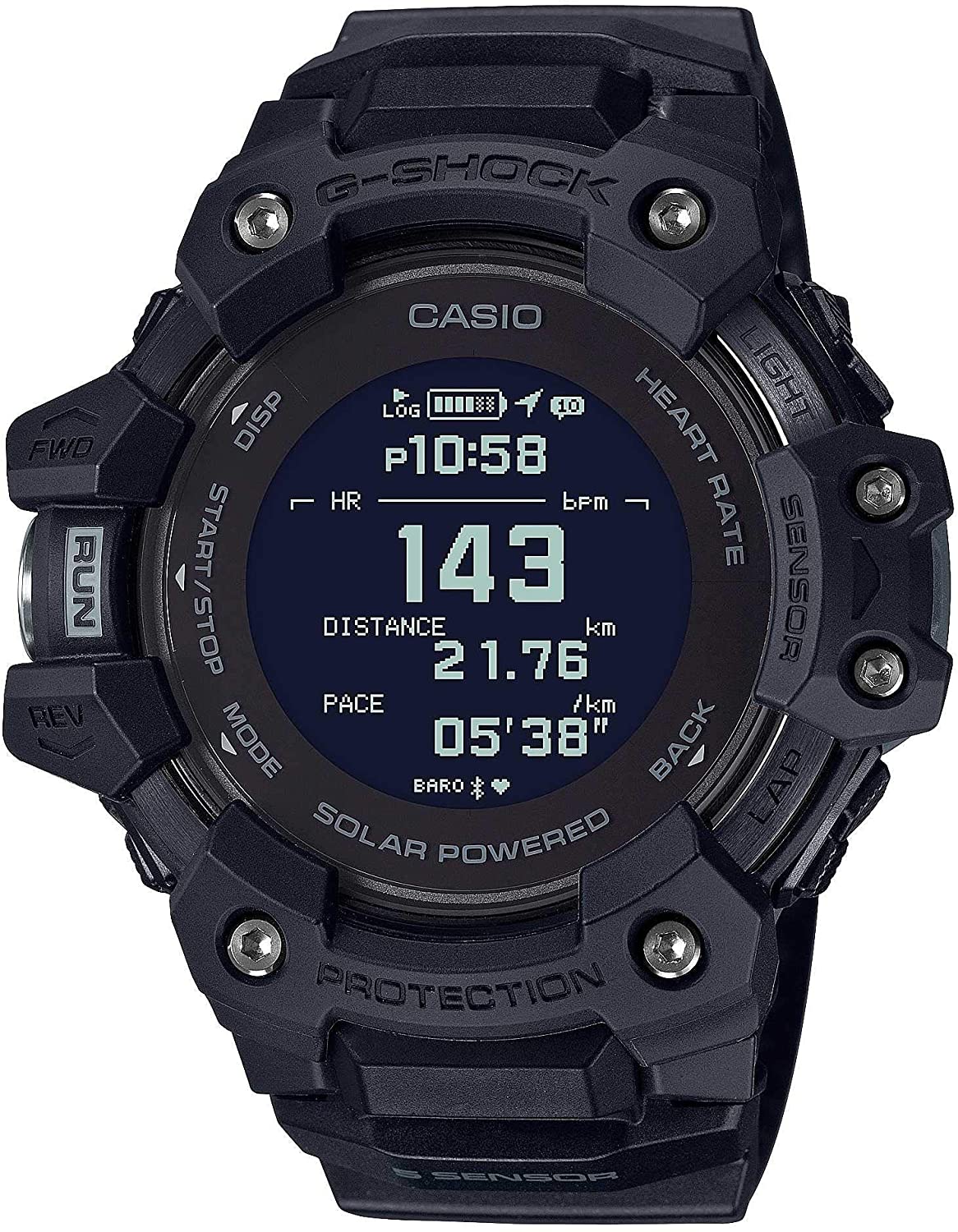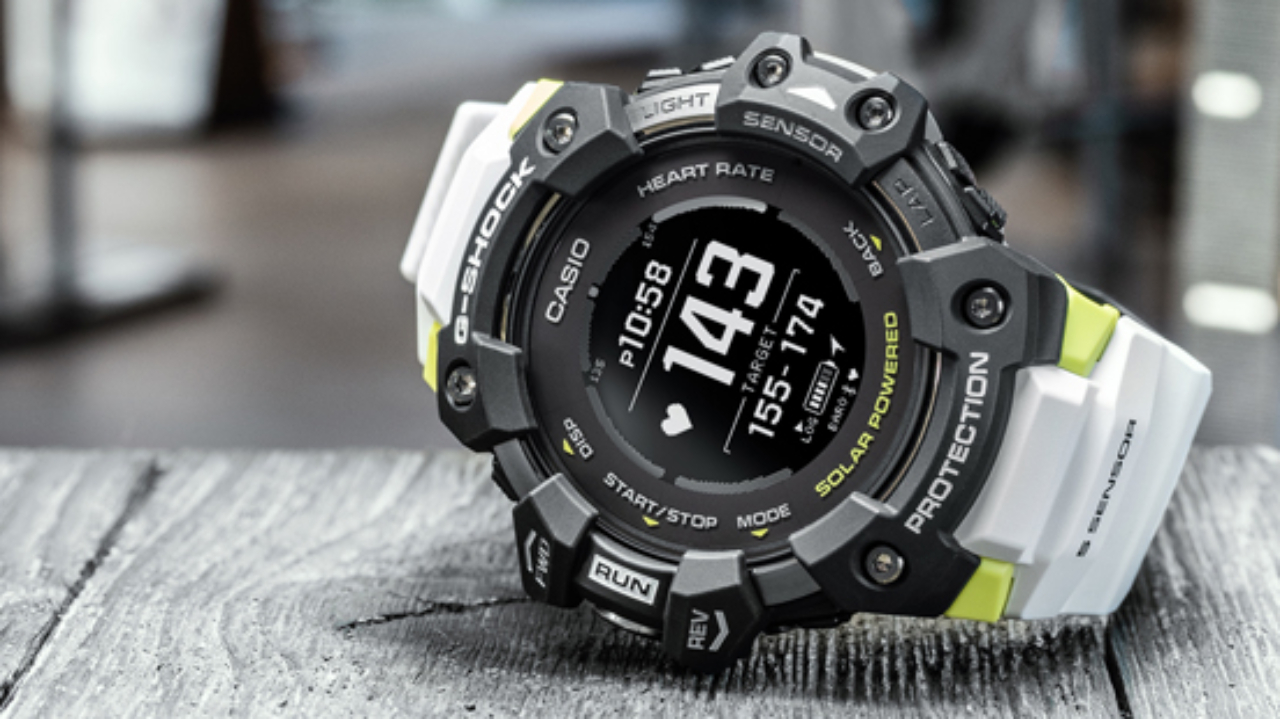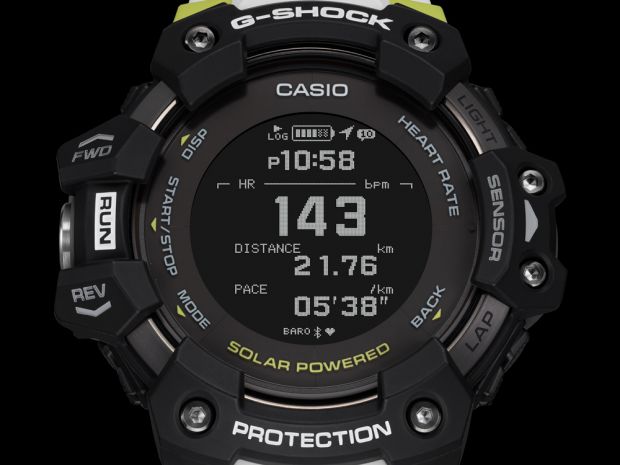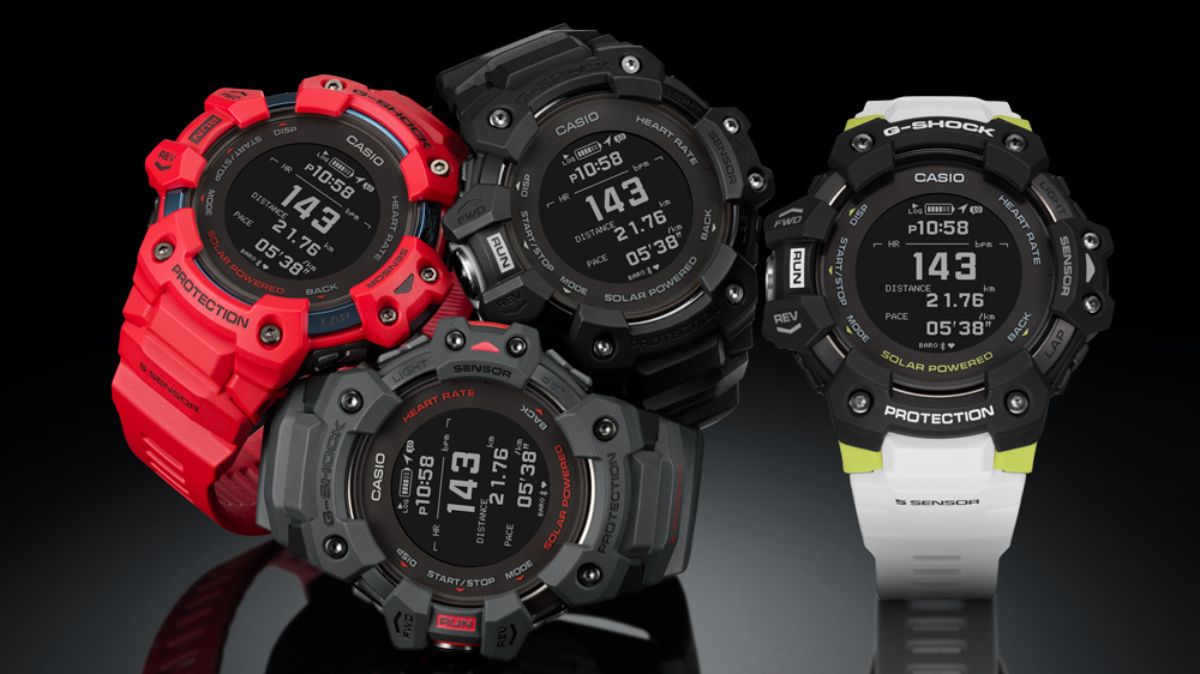Our Verdict
A fitness tracker that tracks only runs, this clunky retro smartwatch is lacking in smarts.
For
- Excellent battery life
- LED display is easy to read
- Extremely tough
Against
- Basic functionality
- Confusing user interface
- Heavy
- Uncomfortable to wear
You can trust Coach
The Casio G-Shock GBD-H1000 is a strange beast, and while it will certainly have a following – chiefly those nostalgic for the Casio watches of old – for most people it will be no more than a curiosity. It’s bulky, not hugely comfortable and unapologetically retro.

It’s also not that smart. While it provides notifications, you can forget any kind of app store – which is just as well as the watch is a nightmare to navigate, even with the manual close at hand. And although it does have GPS and heart rate monitoring built in, it only supports running.
It has plus points, both in hardware and software. VO2 max estimation and training plans are welcome and the battery life is extraordinary thanks to the built-in solar panel in the screen, but it still doesn’t add up to £370 for anybody but the biggest of Casio fans.
CASIO G-Shock Digital GBD-H1000-1ER
Buy from G-Shock | £370
See related
Casio G-Shock GBD-H1000 In-Depth
Close your eyes and picture a smartwatch. It almost certainly doesn’t look like the Casio G-Shock GBD-H1000, which is about as far removed from the Apple Watch 6 or Samsung Galaxy Watch 3 as it’s possible for a wearable to be.
The GBD-H1000 is a big, unapologetically chunky watch that fully embraces Casio’s G-Shock heritage right down to the monochrome display and instantly recognisable beep when buttons are pressed. The G-Shock tradition means that while your average smartwatch might not survive a tumble or graze, the Casio GBD-H1000 practically invites punishment, with its combination of stainless steel and resin ready to absorb the shock and protect the screen at all costs.
That comes at a cost, and nobody in their right mind could call the G-Shock GBD-H1000 dainty. It sticks 20.4mm off the wrist and tips the scales at 101g – that’s more than the weight of three 40mm aluminum Apple Watch 5s. It’s not hugely comfortable, either, with rigid plastic straps that never comfortably mould to the skin, no matter how long you wear it for.
In other words, this is like no smartwatch you’ve ever seen before.
Smart Features On The Casio G-Shock GBD-H1000
Appearances can be deceptive, though, and the Casio G-Shock GBD-H1000 is indeed a smartwatch, with some of the trappings of the latest Garmin or Polar timepiece. It has built-in GPS and heart rate tracking, along with a compass, altimeter, barometer and temperature sensor.
And because the watch can be charged via the sun’s rays, battery drain that was already pretty minimal is barely noticeable on anything but the longest of runs.
But in other respects, the Casio G-Shock GBD-H1000 is distinctly dumb – or at least, nowhere near as smart as its rivals. There’s no sleep tracking, for a start, although frankly anybody who has worn the watch for an extended period would be pretty grateful for that: it’s not something you want to wear to bed.

More damningly, while the Casio G-Shock GBD-H1000 offers plenty to runners (more on that later), no other sports are supported: no cycling, no swimming, no basic gym use. It’s aimed at runners only, which seems pretty bloody-minded when it has no shortage of sensors and is waterproof to 200m.
What about notifications? Well, they’re there, and accompanied by the classic Casio beep, but not in a way that you’ll want to use very much. The Casio G-Shock GBD-H1000 is a labyrinth of menus operated via the five physical buttons embedded on the sides.
To get to your notifications, you have to scroll down through a menu, then click on the notification you want to open. How do you know which one you want? Well, it has a timestamp and the app it’s from, but no room for much else. So good luck if you’re getting a lot of WhatsApp messages and are trying to find a specific one from the list.
Ultimately, it’s fiddly but very slightly better than nothing. It acts as a filter to give you the vague idea of the urgency – you might want to check an SMS, say, but not an email – but you’ll still want to check your phone to really engage with it.
The general interface is one of the least intuitive I’ve ever used. Even after extended use and consulting the flow chart-packed manual, I’m still slipping up and pressing the wrong buttons all the time.
There are five buttons, some of which are context-sensitive, some of which aren’t. Typically, this set-up would be pretty intuitive: a go button, two for up/down navigation, one for light and one for back. That’s how it works some of the time, but from the main screen, what you would assume to be up and down are actually for cycling between displays and “mode”. So rather than cycling through the same feature set, each one will take you off in a mysterious new direction.
Combine this with the fact that the manual has all kinds of hidden features for long presses, and you’ll understand why I think the interface could do with some work. A five-button approach works fine for plenty of wearables with similar functionality – Garmin and Polar both have watches with this set-up. Casio should take a leaf out of those brands’ books and simplify.
Tracking Activity With The Casio G-Shock GBD-H1000
As mentioned above, there’s not much activity tracking the Casio G-Shock GBD-H1000 will do, so this section will be brief.
Other than running, the watch is close in function to the early Fitbits, back when the wearable was a slightly fancy pedometer. The GBD-H1000 will track steps, estimate your calorie burn and show you your heart rate averages. That’s your lot.
Running With The Casio G-Shock GBD-H1000
So, how is running? It stumbles from the off because of how long the GPS takes to lock on. While the Garmin Forerunner 245 on my left wrist connects almost instantly, the Casio G-Shock GBD-H1000 would take 30 seconds to well over a minute. That’s fine in warm weather, but it will be infuriating on a cold winter morning when you just want to get your blood pumping as fast as possible.
Once connected, it’s not a bad experience, with a decent amount of data displayed on screen and because it’s an LCD, there’s no problem with readability or having to wake up the display mid-run. By default, the watch shows the time, your current running time (splittable), the total distance covered and your current pace on the first screen and then things like the compass, temperature and heart rate on additional screens.

You can have each of these screens display different information by pressing the display button, so there’s a lot of data to chew through on the move, even if it’s not hugely obvious how to do it. They’re also customisable, which is definitely welcome, though you wouldn’t know that without finding a very specific part of the manual.
Unfortunately, the Casio G-Shock Move app just would not play ball for me. I connected the watch fine, but it flatly refused to sync any run data, always telling me it wasn’t connected, despite telling me elsewhere on my phone that it was indeed paired. I fruitlessly worked away at this problem for some time, including resets and reinstalls, but got nowhere. So the data had to be read off the watch screen instead of the app – an experience that, thanks to the horrendous UI, was not fun at all.
Over three runs of 4-5km, with the Casio G-Shock GBD-H1000 on one wrist and the Garmin Forerunner 245 on the other, the Casio was between 0.22 and 0.08km behind. Having painstakingly retraced the final route on my final run through Mapometer, I can confirm that it was 4.99km – a distance measured as 5km by the Garmin but 4.78km by the Casio. It’s not a catastrophic difference, but considering the amount of time it takes to lock on – not to mention the sheer size of the thing – you’d hope for a little better.
And that’s a pity because, despite its barebones nature, it does have a couple of nice extras for runners. It will estimate your VO2 max, tell you the aerobic and anaerobic impact of your workout, and use the data gleaned to tell you how long to rest between exercises. It will also set up training schedules for you, based on what you want to achieve and the timescale over which you want to achieve it. It’s genuinely nice stuff for runners, though nothing you couldn’t get on a mid-level Garmin, like the Forerunner 245 – which is considerably cheaper.
Battery Life On The Casio G-Shock GBD-H1000
This is very much the Casio G-Shock GBD-H1000’s killer feature. You’re unlikely to use the charger very often – in fact, I was genuinely concerned that I might misplace it before sending the review model back.
While the battery life is quoted as 12 months of simple timekeeping, or 66 hours with continuous heart rate monitoring enabled, the truth is that if you’re an outdoorsy type who wears the watch everywhere you’ll get a whole lot more than that.
That’s because it has a solar panel integrated directly into the display. As long as your watch is exposed to light, it’s charging – and that means that everyone but those on a regular schedule of GPS-using ultramarathons will find that the charge cable can largely be forgotten (although try not to lose it because it’s a proprietary USB cable so will be a pain to replace).
This, combined with power-saving functionality that will automatically dim the display when in the dark between 10pm and 6am, means that I’ve only used the charger twice since getting my review unit. The first of these before I realised it was basically unnecessary, and the second when I inadvertently left the GPS running overnight while trying to note down the various metrics for this review. Even then, it wasn’t dead the next morning – just on “low battery”. Outstanding.
Where Can I Wear It Without People Laughing At Me?
Probably only the Casio G-Shock Appreciation Society, to be completely blunt. Make no mistake: the design of this watch is a distinctly acquired taste with its huge, chunky footprint, angular ridges and overly annotated bezel.
Some people will undoubtedly love it, but even its biggest fans would agree it’s not something that should be worn to black-tie events or probably even a modestly upmarket restaurant. Even if it could be made more formal with different straps, the watch face itself would still stick out like the sorest thumb on the planet.
Should You Buy Something Else?
The Casio G-Shock GBD-H1000 has a couple of very strong points going for it: the display is easily readable and the battery could last indefinitely with enough sunlight.
But honestly, that won’t be enough for most people. It’s bulky, it’s uncomfortable, it only supports running and it has the most confusing UI I’ve used in all my years reviewing smartwatches. Add in the fact that it’s not that smart and somehow costs £379 and it’s really game over for Casio.
So yes, you should buy something else, and for that kind of money you’re spoiled for choice: iPhone users should look no further than the brand new Apple Watch Series 6 which starts at £379 – or if they want to save a few bob, then maybe the Apple Watch SE at £269. Android enthusiasts can get hold of the Polar Grit X for £379, the Garmin Forerunner 245 Music (£300) or the Fenix 6 Pro (£600).
All these options are more feature-packed and user-friendly. And while none will last as long as the Casio G-Shock GBD-H1000, each one is more comfortable and can be worn anywhere without judgement.
Buy from G-Shock | £370
Alan is a freelance tech journalist and mostly covers fitness trackers for Coach.
Alan was not what you would call a big fitness guy growing up, but has been radicalised by parkrun and taken up running in a big way. Although nowhere near podium at races, as a late starter he does at least know that he can still get faster. Alan has written for ShortList, Tom’s Guide, Trusted Reviews and Expert Reviews, among others.


